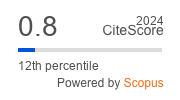Structure and gas sensitive properties of oxide compositions WO3—In2O3 and WO3—Co3O4
https://doi.org/10.17073/1609-3577-2019-1-53-66
Abstract
About the Authors
Yu. S. HaidukYulyan S. Haiduk: Researcher
4 Nezavisimosti Ave., Minsk 220030, Belarus
A. A. Khort
Alexander A. Khort: Cand. Sci. (Chem.), Senior Researcher
15 Brovki Str., Minsk 220072, Belarus
M. A. Makhavikou
Maxim A. Makhavikou: Junior Researcher
4 Nezavisimosti Ave., Minsk 220030, Belarus
A. A. Savitsky
Alexander A. Savitsky: Cand. Sci. (Chem.), Associate Professor, Department of Physical Chemistry
4 Nezavisimosti Ave., Minsk 220030, Belarus
References
1. Barsan N., Koziej D., Weimar U. Metal oxide-based gas sensor research: How to? Sensors and Actuators B. Chemistry. 2007, vol. 121, pp. 18—35. DOI: 10.1016/j.snb.2006.09.047
2. Haiduk Y. S., Lomonosov V. A., Savitsky A. A. Physico-chemical properties of oxide composition WO3—In2O3 prepared by the sol-gel method. Vestnik BGU. Ser. 2, Khimiya. Biol. Geogr. 2016, no. 3, pp. 36—44 (In Russ.). URL: http://elib.bsu.by/handle/123456789/171465
3. Haiduk Yu. S., Lomonosov V. A., Savitsky A. A. Physico-chemical properties of oxide composition WO3–Co3O4, prepared by the sol-gel method. Izvestiya Natsional’noi Akademii nauk Belarusi. Seriya khimicheskikh nauk. 2015, no. 2, pp. 9—13. (In Russ.). URL: https://vestichem.belnauka.by/jour/article/viewFile/148/148
4. Haiduk Y. S., Savitsky A. A., Reutskaya O. G., Taratyn A. A. Semiconductor gas sensors based on the composition of tungsten oxide and indium oxide. Nano- i mikrosistemnaya tekhnika. 2018, no. 4, pp. 232—242. (In Russ.)
5. Haiduk Yu. S., Khort A. A., Lapchuk N. M., Savitsky A. A. Study of WO3—In2O3 nanocomposites for highly sensitive CO and NO2 gas sensors. J. Solid State Chemistry. 2019, vol. 273, pp. 25—31. DOI: 10.1016/j.jssc.2019.02.023
6. Iveronova V. I., Revkievich G. P. Theory of X-ray scattering. Moscow: Izdatelstvo Mokovskogo universiteta, 1978. 278 p. (pp. 136—139). (In Russ.)
7. Klyachko-Gurvich A. L. A simplified method for determining the surface by air adsorption. Izvestiya Akademii Nauk SSSR. Seriya khimicheskikh nauk. 1961, no. 10, pp. 1884—1886. (In Russ.)
8. Krichmar S. I., Bezpal’chenko V. M., Mishekin A. A.
9. A simple method for obtaining calibration gas mixtures. Zavodskaya laboratoriya. Diagnostika materialov. 2008, vol. 74, no. 1, pp. 21—22. (In Russ.)
10. Kang S.-J. L. Sintering: densification, grain growth and microstructure. Butterworth-Heinemann, 2005. 279 p.
11. Kumar V. Bh., Mochanta D. Formation of nanoscale tungsten oxide structures and colouration characteristics. Bulletin of Material Science. 2011, vol. 34, no. 3, pp. 435—442. DOI: 10.1007/s12034-011-0117-1
12. Noguera H., Cavalerio A., Rocha J., Trindade T., Pedrosa J. J. Synthesis and characterization of tungsten trioxide powders prepared from tungstic acids. Materials Research Bulletin. 2004, vol. 39, pp. 683—693. DOI: 10.1016/j.materresbull.2003.11.004
13. Shi J., Hu G., Cong R., Bu H., Dai. N. Controllable synthesis of WO3•nH2O microcrystals with various morphologies by a facile inorganic route and their photocatalytic activities. New J. Chemistry. 2013, vol. 37, no. 5. pp. 1538—1544. DOI: 10.1039/C3NJ41159A
14. Ştefan M., Bica E., Muresan L., Grecu R., Indrea E., Trif M., Popovici E. J. Synthesis and characterisation of tungsten trioxide powder prepared by sol-gel route. J. Optoelectronics and Advanced Materials. 2010, vol. 2, no. 1, pp. 115—118.
15. Nogueira H., Cavaleiro A., Rocha J., Trindado T., Pedrosa de Jesus J. Synthesis and characterization of tungsten trioxide powders prepared from tungstic acids. Materials Research Bulletin. 2004, vol. 39, pp. 683—693. DOI: 10.1016/j.materresbull.2003.11.004
16. Shimizu Y., Matsunaga N., Hyodo T., Egashira M. Improvement of SO2 sensing properties of WO3 by noble metal loading. Sensors and Actuators B: Chemical. 2001, vol. 77, pp. 35—45. DOI: 10.1016/S0925-4005(01)00669-4
17. Sobotta H., Neumann H., Küchn G., Riede V. Infrared lattice vibrations of In2O3. Crystal Research and Technology. 1990, vol. 25, no. 1, pp. 61—64. DOI: 10.1002/crat.2170250112
18. Liu G. Synthesis, characterization of In2O3 nanocrystals and their photoluminescence property. Int. J. Electrochem. Sci. 2011, vol. 6, no. 6, pp. 2162—2170. URL: http://www.electrochemsci.org/papers/vol6/6062162.pdf
19. Salavati-Niasari M., Mir N., Davar F. Synthesis and characterization of Co3O4 nanorods by thermal decomposition of cobalt oxalate. J. Phys. Chem. Solids, 2009, vol. 70, no. 5, pp. 847—852. DOI: 10.1016/j.ica.2009.07.023
20. Sharifi S. L., Shakur H. R., Mirzaei A., Hosseini, M. H. Characterization of cobalt oxide Co3O4 nanoparticles prepared by various methods: effect of calcination temperatures on size, dimension and catalytic decomposition of hydrogen peroxide. Int. J. Nanosci. Nanotechnol., 2013, vol. 9, no. 1, pp. 51—58. URL: http://www.ijnnonline.net/article_3880_cf0693bb7ba98dbdd64b6cb4ae3c88de.pdf
21. Wöllenstain J., Burgmair M., Plescher G., Sulima T., Hildenbrand J., Böttner H., Eisele I. Cobalt oxide based gas sensor on silicon substrate for operation at low temperatures. Sens. Actuators B: Chem., 2003, vol. 93, no. 1–3. pp. 442—447. DOI: 10.1016/S0925-4005(03)00168-0
22. Devadatha D., Raveendran R. Structural and dielectric characterization of nickel-cobalt oxide nanocomposite. J. Material Sci. Eng., 2013, vol. S11, pp. 003. DOI: 10.4172/2169-0022.S11-003
23. Tang Ch.-W., Wang Ch.-B., Chien Sh.-H. Characterization of cobalt oxides studied by FT-IR, Raman, TPR and TG-MS. Thermochimica Acta, 2008, vol. 473, no. 1-2, pp. 68—73. DOI: 10.1016/j.tca.2008.04.015
24. Khatko V., Llobet E., Vilanova X., Brezmes J., Hubalek J., Malysz K., Corrieg X. Gas sensing properties of nanoparticle indium-doped WO3 thick films. Sens. Actuators B: Chem., 2005, vol. 111-112, pp. 45—51. DOI: 10.1016/j.snb.2005.06.060
25. Pierson R. H., Fletcher A. N., Clair Gantz E. St. Catalog of infrared spectra for qualitative analysis of gases. Analythical Chemistry, 1956, vol. 28, no. 8, pp. 1218—1239. DOI: 10.1021/ac60116a002
26. Choi J.-S., Sakai Go, Shimano K., Yamazoe N. Sensing properties of SnO2-Co3O4 composites to CO and H2. Sens. Actuators B: Chem., 2004, vol. 98, pp. 166—173. DOI: 10.1016/j.snb.2003.09.033
27. Haiduk Yu. S., Taratyn I. A. Nitrogen dioxide sensor. Application for the invention of the Republic of Belarus. МПК G01N 27/407; № а 20140371; appl. 08.07.2014; publ. 28.02.2016. Aficyjny biulieteń Nacyjanaĺnaha centra inteliektuaĺnaj ulasnasci Respubliki Bielaruś, 2016, no. 1, p. 44. (In Russ.)
Review
For citations:
Haiduk Yu.S., Khort A.A., Makhavikou M.A., Savitsky A.A. Structure and gas sensitive properties of oxide compositions WO3—In2O3 and WO3—Co3O4. Izvestiya Vysshikh Uchebnykh Zavedenii. Materialy Elektronnoi Tekhniki = Materials of Electronics Engineering. 2019;22(1):53-66. (In Russ.) https://doi.org/10.17073/1609-3577-2019-1-53-66





































